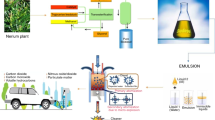Abstract
The purpose of this study is to understand the physical and chemical characteristics of biodiesel blended fuel reformed by ultrasonic energy irradiation. To do this, a mixture of commercial diesel fuel and biodiesel was compared and analyzed according to whether or not ultrasonic energy irradiation was performed and the duration of irradiation. The results of the experiments indicate that when ultrasonic energy irradiation was performed on biodiesel blended fuel, its viscosity decreased by 3–7%. In the case of BD20, when ultrasonic energy irradiation was performed, its Sauter mean diameter (SMD) dropped by 12% on average. As the irradiation duration increased, the volume ratio of olefins increased up to a maximum of 2.7%, and the higher heating value increased to a maximum of 5.8%. On the contrary, the ratio of aromatics decreased by a maximum of 2.7%, and BI decreased by a maximum of 7%.
Similar content being viewed by others
Abbreviations
- TMS:
-
tetramethylsilane, (CH3)4Si
- FFT:
-
fast Fourier transform
- Hi :
-
hydrogen types of hydrocarbon
- Ca, Cα, C2, C3 :
-
carbon types of hydrocarbon
References
Bae, M. W., Ryu, C. S., Ha, T. Y., Kim, J. O. and Kim, H. M. (2002). Effect of intake mixture temperature on exhaust emissions in diesel engine with scrubber EGR system. Spring Conf. Proc. Korean Society Automotive Engnieers, 373–379.
Baik, D. S. (2006), Combined effects of BD20, low sulfur diesel fuel and diesel oxidation catalyst in a HD diesel engine. Int. J. Automotive Technology 7,6, 653–658.
Bailey, B. K. Russell, J. A., Wimer, W. W. and Buckingham, J. P. (1986). Cetane number prediction from proton-type distribution and relative hydrogen population. SAE Paper No. 861521.
Choi, D. S. (1996). A Study on the Automization Characteristics and the Engine Performance Characteristics of the Ultrasonic-Energy-Added Diesel Fuel. Chungnam National University. Ph. D. Dissertation. Chungnam. Korea.
Choi, D. S. and Ryu, J. I. (1997). Performance characteristics of a diesel engine using the change of injection nozzle type and ultrasonic-energy-added system (I). Trans. Korean Society Automotive Engnieers 5,4, 160–170.
Choi, J. S. (2000). Analysis Chemistry and Instruments Analysis. Dong-wha Technology. 260–281.
Gülder, Ö. L. and Glavincevski, B. (1986). Ignition quality determination of diesel fuels from hydrogen type distribution of hydrocarbons. Combustion and Flame 63,1–2, 231–238.
Gülder, Ö. L., Glavincevski, B. and Kassinger, R. (1987). Ignition quality determination of marine diesel fuels. SAE Paper No. 872144.
Kang, M. K. and Kim, J. H. (2005). Biodiesel. J. Korean Society Automotive Engnieers 27,2, 12–20.
Kim, Y. C., Song, Y. S. and Ryu, J. I. (2004). A study on the various characteristics of ultrasonic-energy-added W/O type emulsified fuel (I)-Attaching importance stability and spray characteristics-J. ILASS-KOREA 9,3, 22–28.
Neto da Silva, F., Prata, A. S. and Teixeira, J. R. (2003). technical feasibility assessment of oleic sunflower methyl ester utilization in diesel bus engines. Energy Conversion and Management, 44, 2857–2878.
Noltingk, B. E. and Neppiras, E. A. (1951). Cavitation produced by ultrasonic; Theoretical conditions for the onset of cavitation. Proc. Phys. Soc., 64B, 1032.
Ryu, K. H., Yun, Y. J. and Oh, Y. T. (2002). The characteristics of performance and emissions of agricultural diesel engine using biodiesel fuel. Proc. KSAE Gwangju Honam Branch 2002 Spring Conference. Korean Society Automotive Engnieers, 9–16.
Ryu, K. H. and Oh, Y. T. (2003). A study on the usability of biodiesel fuel derived from rice bran oil as alternative fuel for DI diesel engine. KSME Int. J. 17,2, 310–317.
Author information
Authors and Affiliations
Corresponding author
Rights and permissions
About this article
Cite this article
Im, S.Y., Song, Y.S. & Ryu, J.I. Experimental study of the physical and chemical characteristics of biodiesel blended fuel using ultrasonic energy irradiation. Int.J Automot. Technol. 9, 249–256 (2008). https://doi.org/10.1007/s12239-008-0031-8
Received:
Revised:
Published:
Issue Date:
DOI: https://doi.org/10.1007/s12239-008-0031-8




